Adromischus subdistichus
Adromischus subdistichus Makin ex Bruyns
Family: Crassulaceae
Common names: book-stonecrop (Eng.), boekieplakkie (Afr.)
Introduction
The book-stonecrop is a dwarf, mat-forming to pendent, leaf succulent from the mountainous regions near Willowmore in Eastern Cape. The rounded flattened leaves are arranged in opposite rows. The pinkish flowers appear in summer. Easily grown in containers and propagated from leaves. Best as a pot plant.
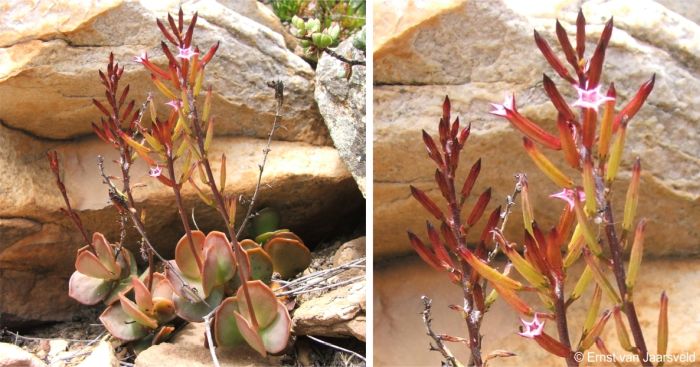
Fig. 1. Adromischus subdistichus in flower, growing on a ledge on the Aasvoelberg near Willowmore, Eastern Cape.
Description
Description
Adromischus subdistichus is a small, little-branched, decumbent to erect plant, up to 70 mm high, 150 mm in diameter. Roots fibrous. Branches green at first, becoming grey-green, 3–5 mm in diameter. Leaves 15–20 × 10–17 mm, spreading to ascending, brittle, obovate, grey-green, shiny, sometimes purplish but not spotted; adaxial surface flat to convex; abaxial surface convex; margin white, acute, horny for most of the length, shortly decurrent on stem; apex obtuse or rounded, mucronate; base auriculate. Inflorescence a spike-like thyrse up to 180 mm long, bearing 1- or 2-flowered cymes; pedicel 4–8 mm long; buds spreading, terete, tapering. Calyx up to 2 mm long. Corolla 11–12 mm long; tube greenish-yellow; lobes lanceolate-triangular, 3–4 mm long, pink, with club-shaped trichomes in throat; apices acute. Anthers shortly exserted. Flowering mainly in summer (November to January, southern hemisphere).
Fig. 2. (left) A drooping plant of Adromischus subdistichus growing on a sheer cliff at Toorwaterspoort, and (right) Adromischus subdistichus growing on the Nuwekloof Pass, east of Willowmore, together with Delosperma esterhuyseniae and Haworthiopsis viscosa.
Conservation Status
Status
Assessed as Least Concern (LC) by the Red List of South African Plants. It is not threatened, the plants are locally common and safeguarded by the difficult to reach habitat as well as its distribution falling within a greater conservation region.
Distribution and habitat
Distribution description
Adromischus subdistichus grows on sheltered cliffs, confined to the eastern Klein Karoo, from Prince Albert to Toorwaterspoort and along the Boesmanspoortberge (west of Willowmore) to the Nuwekloof Pass at the western end of Baviaanskloof at an altitude of 800–1 500 m. It was also recorded southwards to near Uniondale.
Adromischus subdistichus grows on mineral-poor quartzitic sandstone soil (Witteberg Formation, Cape Supergroup) usually on shady southern aspects. The average daily maximum temperature is about 26°C and the average daily minimum 11°C. Temperatures vary and may reach 40°C in summer. Winters are cooler but frost is a rarity or absent. Although the rainfall occurs in summer and winter (from 300–400 mm per annum), it is more abundant during the summer months.
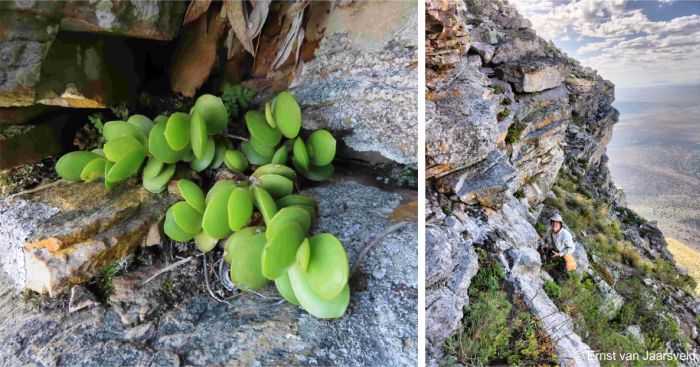
Fig. 3. (left) Adromischus subdistichus growing in a shaded, moist position on a shady south-facing cliff face of the Aasvoelberg. (right) The upper south-facing cliffs of the Aasvoelberg, habitat of Adromischus subdistichus.
The vegetation consist of a mosaic of Groot Thicket and Fynbos. Associated cliff-dwelling plants in its habitat at Toorwaterspoort south-west of Willowmore include: Albuca tortuosa, Bulbine rupicola, Carruanthus peersii, Cotyledon woodii, Crassula capitella subsp. thyrsiflora, Crassula cotyledonis, Crassula muscosa var. muscosa, Crassula pellucida subsp. marginalis, Crassula perfoliata var. minor, Crassula pubescens subsp. radicans, Crassula rupestris, Cyrtanthus montanus, Drimia uniflora (= Litanthus pusillus), Haemanthus albiflos, Haworthia decipiens var. decipiens, Haworthiopsis viscosa, Lampranthus affinis and Curio talinoides.
On the Aasvoelberg plants, plants grow on the upper south-facing cliffs among Cotyledon orbiculata, Crassothona cacalioides (= Othonna carnosa), Crassula pellucida subsp. marginalis, Haworthia monticola, Delosperma esterhuyseniae, Crassula atropurpurea var. muirii, Bulbine rupicola, Drosanthemum aasvoelbergense, Teedia pubescens, Drimia minor and Crassula socialis. On the Nuwekloof Pass, en route to the western Baviaanskloof, plants grow on cliffs and share the habitat with Delosperma esterhuyseniae, Haworthiopsis viscosa, Cynanchum viminale and Crassula rupestris.
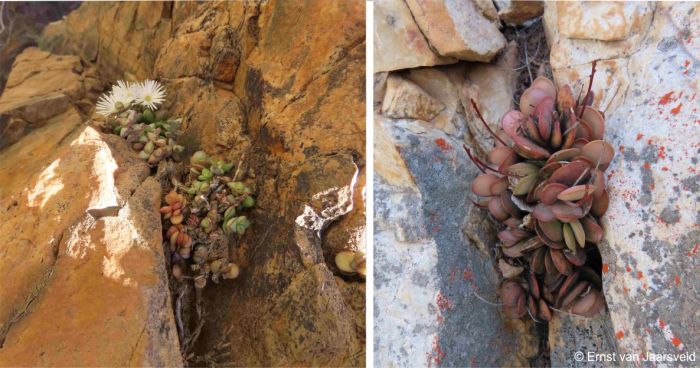
Fig. 4. Adromischus subdistichus growing on the Boesmanspoortberge, near Willowmore, Eastern Cape, (left) sharing its habitat with Delosperma esterhuyseniae and Crassula rupestris, the plants filling the crevice, (right) a cluster of Adromischus subdistichus with reddish-purple leaves.
Derivation of name and historical aspects
History
Adromischus subdistichus was named by the mathematician and botanist Peter Bruyns in the South African Journal of Botany in 1992. Brian Makin from Britain suggested the name subdistichus which Peter adopted. The species name is of Latin and Greek origin, sub, meaning ‘almost’, dis, ‘twice’, and stichus, ‘a line’, pertaining to the leaves of younger plants which are almost in two opposite rows. There are 28 species of Adromischus occurring in South Africa and Namibia. They are usually small plants which grow in arid and semi-arid habitats, most of them have brittle leaves, that when becoming detached will root, proliferate and forming new plants. The genus was subdivided into 5 sections based on floral features.
Adromischus subdistichus is one of 8 Adromischus species that belong in section Adromischus. Section Adromischus was created by Jacobsen in 1966 to accommodate the species with a green cylindrical floral tube with broadly triangular lobes reflexed against the tube, of which the margin is undulate and frilled and with the anthers protruding. The species in this group include: Adromischus alstonii, A. bicolor, A. filicaulis, A. hemisphaericus, A. liebenbergii, A. montium-klingardtii, A. roanianus and A. subdistichus. From these A. subdistichus is at once distinguished by its obovate to rounded (orbicular) brownish-green leaves with a horny margin that is translucent and extends right around the leaf. Superficially it resembles Adromischus leucophyllus, both with similar-sized, sometimes sub-distichus leaves and habit. However, A. leucophyllus has leaves densely covered in a white powdery bloom (farinous), and occurs on cliffs along the western lower slopes of the Swartberg (Cape Folded Mountains) in the Western Cape.
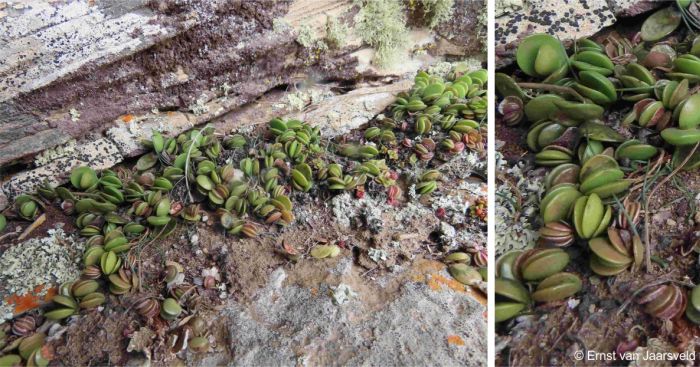
Fig. 5. Adromischus subdistichus growing in shallow soil on a broad ledge on the cliff face below the summit of Aasvoelberg, near Willowmore in the Eastern Cape.
Ecology
Ecology
Adromischus subdistichus is mostly found on south-facing and sheltered cliffs and boulders. Plants form loose, sparsely branched clusters, often with drooping stems to 20 cm long and are well-adapted to their well-drained, vertical habitat. The plant has orbicular, brittle, easily detached, succulent leaves, where moisture is stored. The leaves are greenish-brown turning reddish during periods of drought and thus protecting the plants from excessive sunlight and preventing unnecessary transpiration. Plants are well protected by the sheer, inaccessible habitat. Flowers are pollinated by insects and the erect fruiting capsules dehiscent, with seeds dispersed by wind in autumn, coinciding with the autumn rain and maximising establishment. The seeds are minute and easily lodged in crevices. As with other species of Adromischus, this plant proliferates from detached leaves (caused by disturbances), a vegetative reproductive backup system ensuring long-term survival. On the upper slopes of the Aasvoelberg, at 1 500 m, plants tend to be more green with the increase in rainfall and lower temperatures. The rocks here are covered in lichens due to this part of the mountain often being covered in cloud.
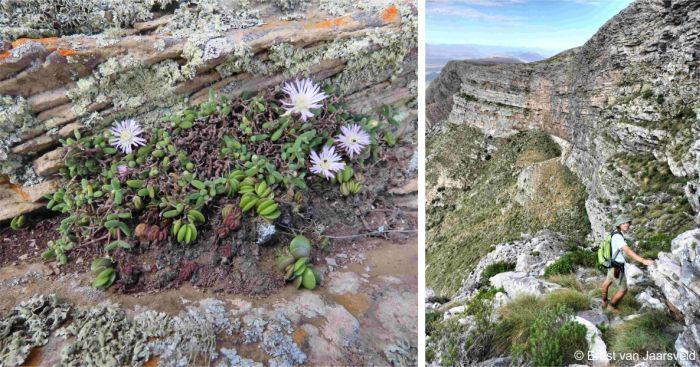
Fig. 6. (left) Adromischus subdistichus growing with Drosanthemum aasvoelbergense on the Aasvoelberg, on a sheer south-facing cliff below the summit. (right) The upper south-facing cliff face at Aasvoelberg near Willowmore, Cornell Beukes standing by.
Uses
Use
No medicinal uses have been recorded. Adromischus subdistichus is easily cultivated and popular in cultivation, best suited to containers or rockeries in thicket, succulent karoo and dry fynbos gardens. In regions outside of its habitat, ceramic containers are the solution. It also grows well with other succulents in miniature succulent gardens where conditions can be controlled.
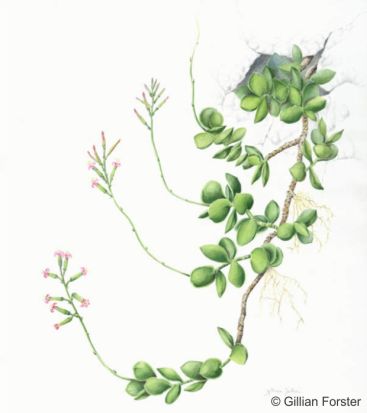
Fig 7. Illustration Adromischus subdistichus by Gillian Forster.
Growing Adromischus subdistichus
Grow
Plants are usually easily grown and grow best in dappled shade in a well-drained gravelly or sandy-loam. Water should be provided throughout the year, but sparingly. Plants rapidly respond to watering, becoming turgid, filling the containers. Plants can be fed with an organic fertiliser throughout the year. Its very easy growing nature maximises its survival rate. Plants adapt well to containers.
Plants are easily propagated by division or leaf cuttings.
Sow seed in winter or spring, in a shallow tray, in a sandy mixture and keep moist. Germination is within 3 weeks and once large enough to handle, transfer to individual containers. Place container in a shady position but with full light. The south side of a building is ideal.
Plants are relatively disease free, except for root rot caused by too much watering, and aphids, wine weevils, slugs and snails can sometimes be a problem.
References
- Bruyns, P. 1992. New taxa from the arid regions of southern Africa. South African Journal of Botany 58(1): 50–51.
- Johnson, M.R., et al. 2006. Sedimentary rocks of the Karoo Supergroup. In M.R. Johnson, C.R. Anhaeusser & R.J. Thomas (eds), The geology of South Africa: 463–501. Geological Society of South Africa, Johannesburg Council for Geoscience, Pretoria.
- Mucina, L. & Rutherford, M.C. (eds) 2006. The vegetation of South Africa, Lesotho and Swaziland. Strelitzia 19. South African National Biodiversity Institute, Pretoria.
- Pilbeam, J., Rodgerson, C. & Tribble, D. 1998. Adromischus. The Cactus File Handbook 3. Cirio Publishing Services, Southampton.
- Raimondo, D., Von Staden, L., Foden, W., Victor, J.E., Helme, N.A., Turner, R.C., Kamundi, D.A. & Manyama, P.A. (eds). in press. Red List of South African plants. Strelitzia 25. South African National Biodiversity Institute, Pretoria.
- Toelken, H.R. 1985. Crassulaceae. Flora of Southern Africa 14: 1–229.
- Van Jaarsveld, E.J. & Van Wyk, A.E. 2003. New cliff-dwelling Crassulaceae from the Eastern Cape: a new Cotyledon and two new Adromischus taxa from the Mbashe and Mzimvubu Rivers, South Africa. Aloe 40(2): 36–40.
- Van Jaarsveld, E.J. 2010. Waterwise gardening in South Africa and Namibia. Struik, Cape Town.
- Van Jaarsvekd, E.J., Nordenstam, B. & Van Wyk, A.E. 2004. Adromischus schuldtianus subsp. brandbergensis, a new subspecies and a checklist of the succulent flora of the Brandberg, Namibia. Bothalia 34: 35–38.
- Von Poellnitz, K. 1940. Zur Kenntnis der Gattungen Cotyledon L. und Adromischus Lem. Feddes repertorium specierum novarum regni vegetabilis, Zeitschrift für systematische Botanik 48: 80–113.
Credits
Ernst van Jaarsveld
Kirstenbosch National Botanical Garden (Retired)
Babylonstoren Farm (Current)
Extraordinary senior lecturer and researcher,
Department of Biodiversity and Conservation, University of the Western Cape
May 2024
Acknowledgements: The author thanks his colleagues at Babylonstoren, Cornell Beukes, Nico van Wyk & Phillip Venter for assistance in the field.
Plant Attributes:
Plant Type: Succulent
SA Distribution: Eastern Cape, Western Cape
Soil type: Sandy
Flowering season: Early Summer, Late Summer
PH: Acid
Flower colour: White, Pink
Aspect: Full Sun, Shade, Morning Sun (Semi Shade)
Gardening skill: Easy
Special Features:
Horticultural zones








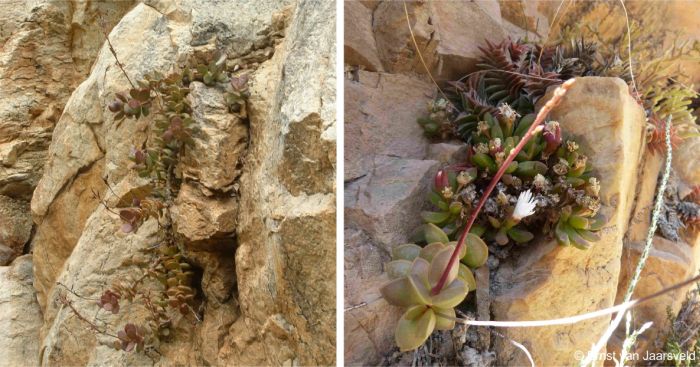
Rate this article
Article well written and informative
Rate this plant
Is this an interesting plant?
Login to add your Comment
Back to topNot registered yet? Click here to register.